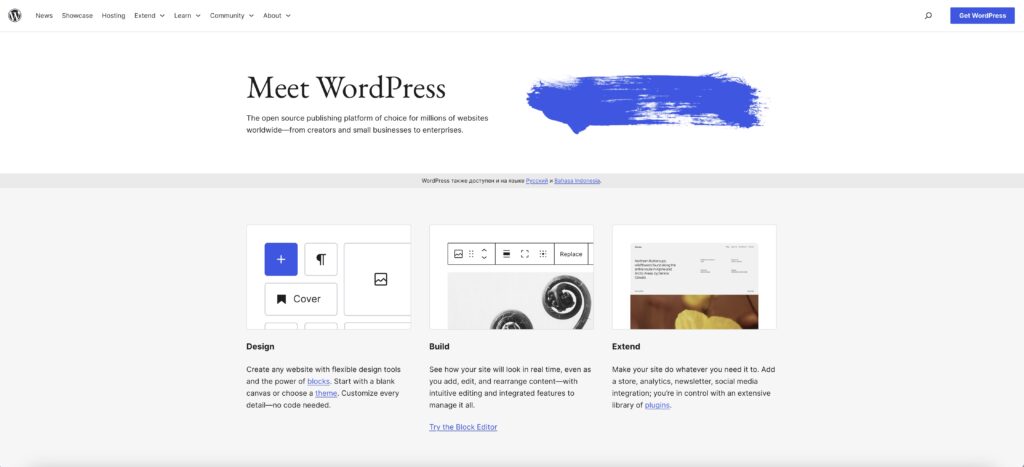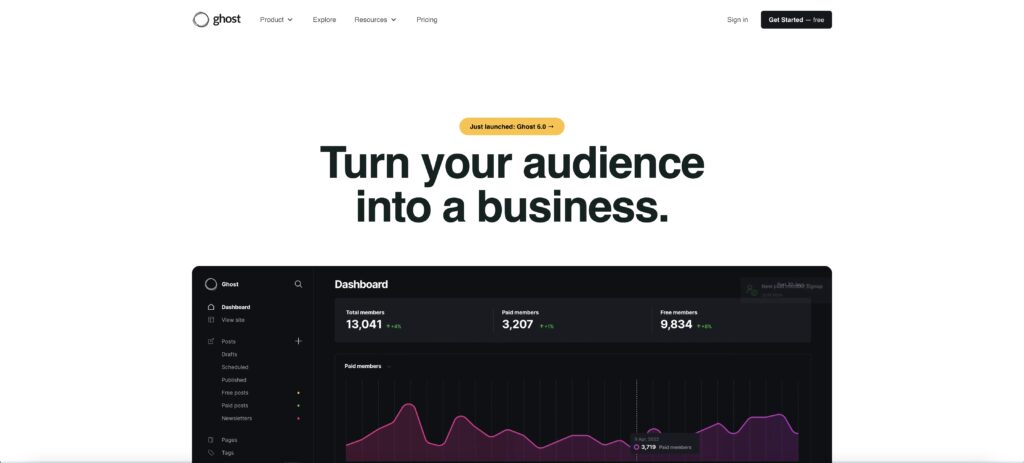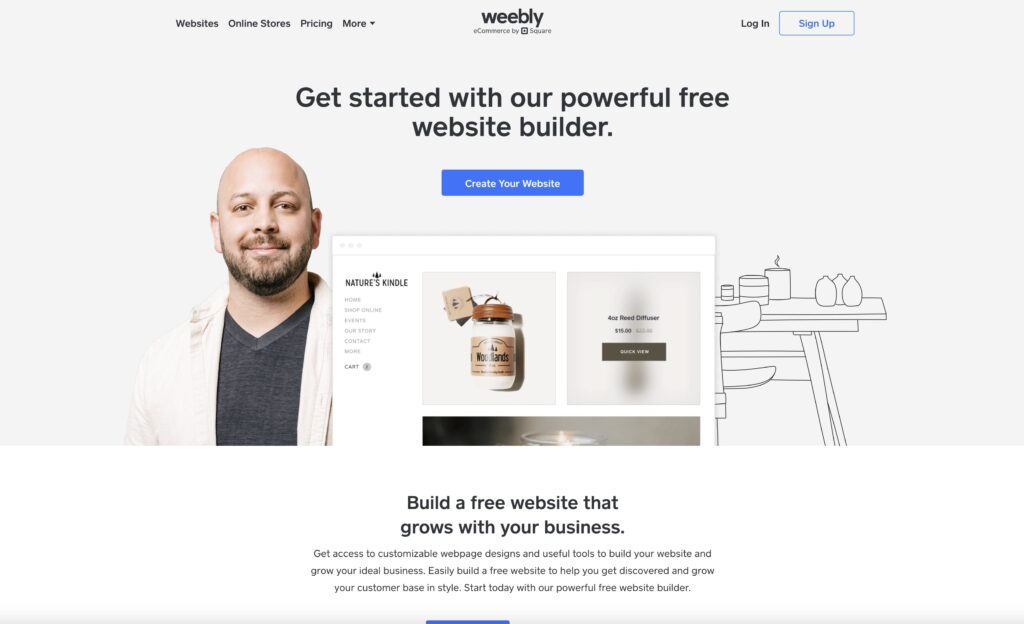Picking the right platform for your blog in 2025 isn’t just a choice – it can make or break your entire online presence. In this ultimate guide, we reveal the 8 best blogging platforms, diving into ease of use, customization, monetization potential, and growth opportunities.

You’ll uncover which platform perfectly matches your goals, gain insider strategies to supercharge your blog’s reach, and get the tools you need to turn your passion into a thriving, profitable online venture.

Monetize your blog with HilltopAds
and get paid every Tuesday.
Blogging has been popular for a while, and 2025 is no exception. The advantages of having a personal blog are numerous:
- Builds authority and credibility for search engines to notice your articles and start recommending them.
- Brings long-term organic traffic, provided your content resonates with your audience.
- Enables multiple monetization streams, e.g., via affiliate links, ads, ebooks, services, subscriptions, sponsored content, etc.
- Creates a loyal community that facilitates monetization of your website.
- Features fewer restrictions in comparison to social media.
Every blog starts with an idea and a platform. Picking the wrong platform for your website can hamper your advancement. That’s why we’re here to elaborate not only on the advantages but also on optimal blogging platforms so you don’t end up bottlenecked if your website takes off.
As a cherry on top, you’ll find commentaries from an invited blogging expert – Amma Ali, the Founder and CEO of RankingGrow.
Having been in the industry for 15 years, he and his agency launched uCompares.com, Advertiser Review, and other platforms, which remain prominent in affiliate marketing in 2025 as well. And now you can tap into his expertise and insights.
Why Choosing the Right Blogging Platform Matters
When you start, you’re focused on the content, but over time, you’ll have to deal with visuals, layout, and, hopefully, monetization matters. That’s why, when choosing your blogging platform, you need to account for scaling possibilities in the future.
But that’s not the only concern here, as a suboptimal platform can limit your visibility or cause difficulties when trying to monetize your blog via ads.
Last but not least, technical complexity can ruin your entry into the world of blogging. This is where you might be forced to choose between ease of entry and scaling potential. And there’s no right or wrong answer – just a thing to account for when deciding what’s suitable for your needs.
Blogs are still very useful in 2025. Unlike social media posts that disappear quickly, blogs stay on Google for years and bring long-term traffic. A blog helps you build authority, share your knowledge, and connect with readers.
You also fully own your blog, which is not the case with social media platforms. Plus, blogs can make money through ads, affiliate links, sponsored posts, or by bringing clients to your business.
How to Choose the Best Blog Platform
There are 7 major criteria to account for when deciding on which blog platform is an optimal pick for your future website. Let’s go over them in order of importance:
Ease of use
An easy-to-understand user interface (UI) is crucial for a good experience, and now we are referring to your experience as a webmaster.
If you’re a beginner in this field, no one is stopping you from mastering difficult blogging platforms on your own, reading official or community guides, and watching videos on YouTube. Just make sure to start with something more intuitive.
Customization features
First impression matters, and the look of your website should match your content. As they say, “the more, the merrier,” and the more customization options you have, the more unique and personal your blog will feel.
It would be a bonus if the platform had a set of templates to jump-start your blogging or at least provide some source of inspiration for tailoring.
Scaling potential
Some platforms are built for low traffic volume, while some can handle increasing volumes without any loss in performance. Besides, as your blog grows, the option to include some advanced features down the road is especially welcome.
Monetization potential
Whether you want your blog to be a full-time job or simply to make some extra cash on the side, don’t overlook the monetization options.
Content features
The quality of the content editor, search engine optimization (SEO) capabilities, contact forms, and blog analytics are also quite important. Some platforms offer these tools for free, while others require you to pay for them.
Security
The bigger your website becomes, the higher the stakes are. You need to keep hackers at bay, so they have no chance to abuse your credibility and damage your reputation.
Make sure your platform provides secure protection from Trojans, worms, distributed denial of service (DDoS) attacks, structured query language (SQL) injections, and so on.
Support team
Finally, a platform is only as good as its staff. It can offer the best customization features and monetization options available, but if the support team neglects their responsibilities when you need them most, it’s better to move your blog to another platform.
The platform you choose is very important. Look for one that is easy to use, SEO-friendly, and secure. It should allow you to grow without limitations.
Think about ownership, too; some free platforms control your content and can shut you down. For serious blogging, pick a platform that gives you freedom, flexibility, and monetization options.

Start monetizing your traffic with HilltopAds
and earn like never before.
8 Best Blog Platforms in 2025
Blogging platforms are numerous, so we have to make priorities. Below, you’ll find 8 popular platforms to choose from. Worry not, we’ll elaborate on each one to ease your choice.
WordPress.org
Before we begin, we must clarify the difference between WordPress.org and WordPress.com. The .com is a simpler, less setup-heavy version of .org. We’ll elaborate on the more complete version – WordPress.org.

WordPress is an undeniable classic. This platform is a choice of small content creators and big businesses like Rolling Stone, Microsoft, and PlayStation.
WordPress powers almost 43% of all websites on the internet, so let’s find out why it’s so popular.
WordPress is an open-source, self-hosted, free (technically, we’ll come back to that in a bit) blogging platform with thousands of themes, endless features, and complete ownership over your website.
It doesn’t matter what you want: an open community, memberships, or an online shop… Just name it, and WordPress will give you the tools to build.
And because the platform is open-source, you can monetize your website however you want, which means that all the profit goes to you, and no one will take a cut from your cake.
This sounds like too sweet a deal to be free, so what’s the catch? There’s none. WordPress is free, but you need to pay for a domain name and hosting (both of which are essential for every website anyway).
While a domain can be registered everywhere, WordPress recommends three hosting providers that work best with their platform: Pressable, Bluehost, and Hostinger.
Every one of them offers protection, 24/7 support from WordPress experts, and a wide selection of subscriptions, so you pay only for what you need.
Pros
- Complete ownership over your blog.
- Lots of different tools and plugins to manage your content.
- You can monetize your website however you want, and you don’t have to share the revenue.
- WordPress is search engine friendly, so you can easily boost your SEO and increase search engine rankings.
- The platform is budget-friendly. Almost everything it offers is free, and the only things you need to pay for are the domain name and hosting.
Cons
- While WordPress isn’t that complicated, it can be overwhelming for beginners. If you have never created a blog before, expect to spend some time learning how everything works.
- Running a website on WordPress is like owning a mansion without servants; be ready to do everything by yourself, from updates to backups.
Medium

Medium is a platform that is all about blogging with no technical knowledge required. Writing there is similar to making posts on social media, like Facebook or X, except you have more space to express your ideas.
The owners of Medium believe that everyone, from amateur novelists to software developers, has a story to tell and experience to share, so they created a minimalistic, ad-free platform.
Their minimalism goes beyond the appearance; Medium provides a straightforward experience, but editing options for blog posts are lacking.
However, what Medium lacks in tools, it makes up for with its audience. Millions of people visit the website daily, and a variety of different categories will ensure that your work finds its readers.
Running a blog with Medium is free of charge, but owners offer memberships to elevate your experience both as a reader and a writer: Medium Member ($5/month or $50/year) and Friend of Medium ($15/month or $150/year).
These memberships provide benefits like reading posts offline and access to audio narrations, but most importantly, you can monetize your content.
Pros
- Working with Medium requires no technical knowledge; just create an account and start writing.
- Great for beginners with tight budgets.
- Your work will be shared in front of millions of potential readers.
- You can monetize your blog through a membership.
Cons
- Minimalism in editing tools for content can be limiting to some people.
- Remember how we compared running a WordPress blog to owning a mansion? Well, working with Medium is like renting an apartment; it’s small and nice, but the platform isn’t yours, and you have to obey the owner’s rules.
- You can monetize your blog only through a membership.
- Medium is basically a social media platform, and social media’s algorithms are sometimes hard to understand. Content that you worked hard on can receive no traction at all, and a simple post that you made in one evening will be shown to everyone on the website.
Due to its nature, Medium is great for beginners. It’s free, simple, and you’re not alone there – you can interact with like-minded people. Medium is convenient for attracting new traffic but has its limitations when it comes to monetization, so we recommend using it in tandem with another platform.
Wix

Wix is a drag-and-drop website builder, another good entry for beginners with zero technical knowledge.
This platform works well for small to medium-sized businesses and beginner bloggers who want to make their website in a couple of hours and begin to work.
Wix offers 900+ fully customizable free website templates, professional support every step of the way, AI tools for content creation and SEO, and mobile optimization for your blog.
Wix offers different membership plans: Light ($17/month), Core ($29/month), Business ($39/month), and Business Elite ($159/month).
All of them cater to different needs, so if you want to keep your blog small and simple, you don’t have to subscribe to the most expensive plan.
As for how you can monetize your website, Wix offers their own eCommerce and Google AdSense integrations, subscriptions, memberships, and call-to-action (CTA) buttons.
But Wix isn’t as perfect as it seems: once you choose one of their website templates, you’re stuck with it forever, moving to other platforms can be a pain, and apps and features are not included in any of the plans.
Pros
- A wide range of templates tailored to any business.
- Easy to understand drag-and-drop website creator.
- AI tools that help with content creation from ideas to fully fledged posts.
- You can monetize your blog however you want.
Cons
- While the platform has a free plan, you can’t do much with it, so consider it more of a demo for paid options.
- With Wix, you’re stuck forever with your choices. It’s impossible to change the website’s template, and if you decide to switch platforms, sometimes it’s better to just start from the beginning, rather than moving your content and domain.
- The cost can add up quickly, as you need to pay separately for apps and features in addition to your already paid plan.
- Poor SEO friendliness means you limit your organic reach – the type of traffic marked by its quality. High SEO ranking is a way to attract many advertisers and monetize your website efficiently.
In the end, if you want a simple, fast, all-in-one solution that will help you quickly create a professional-looking website, Wix is your choice. However, you need to know what you’re getting into with its restrictions and extra costs.

Start monetizing your blog on Wix today.
Ghost

Ghost is a platform that combines the minimalism of Medium and the technical flexibility of WordPress. This is an open-source platform, and as we learned from WordPress, open-source means self-hosted.
If you want a platform that takes blogging to the next level, Ghost is for you. It provides a clean, distraction-free content editor, built-in SEO tools, and monetization through subscriptions and memberships (once again, Ghost is open-sourced, so you keep everything you earn for yourself).
But Ghost isn’t for everyone. While WordPress also requires some technical knowledge, beginners can still manage it if they take their time.
This can’t be said about Ghost, as the platform requires a lot of coding experience. And while the tools it provides are powerful, Ghost lacks the extensive plugin options that are present on previous platforms.
The platform offers four different subscription plans: Starter, Publisher, Business, and Custom (you need to contact their specialists to discuss the details and decide on the price).
Ghost’s pricing is different from other platforms and is directly dependent on the number of visitors to your blog, but the cheapest option (Starter) is $15/month (yearly billing) and is limited to up to 1,000 members.
If you want to try out Ghost, but are not sure if it will suit you, all options have a 14-day free trial.
Pros
- Technical freedom.
- Due to Ghost’s minimalism, you will have a fast and responsive blog, which both users and search engines appreciate.
- SEO tools that work right from the box.
- Clean and clutter-free writing experience.
Cons
- Limited in customization features and plugins.
- Requires extensive technical knowledge to start.
- Due to uncertain membership plan prices, Ghost can quickly become budget-unfriendly.
Ghost is by no means a platform for everyone. Technologically advanced, it is visually striking but straightforward. If you’re a professional blogger who knows their way around the lines of code, this platform is for you, but for beginners, we recommend looking for other options.
HubSpot

HubSpot is a platform that works best for medium to large-sized businesses, and is a choice of companies like eBay, Reddit, DoorDash, and Tripadvisor.
Let’s get it out of the way. If you want to use HubSpot just for your small blog that you run as a hobby, then you won’t get much from this platform. HubSpot is oriented towards businesses that use blogs as one of their marketing tools.
The platform offers a drag-and-drop website builder (just like Wix, so you don’t have to code anything), and AI-powered tools that help you grow your business.
The set of tools includes, but is not limited to, Smart CPM to keep your clients’ data safe, Commerce Hub to make the payment process for your customers easy, and Breeze AI agents that will help you with sales and increase the quality of content in your blog.
But don’t think that you’ll be interacting with bots 24/7, because if there’s a problem that needs a human touch, you can count on HubSpot’s support team.
HubSpot provides different subscriptions, the option to buy their marketing tools separately, create your personal bundle, and start for free with a demo.
For example, with a Customer Platform plan, individuals and small teams can go for free essential tools from Starter Customer Platform ($9/month billed annually), or for full-scale Professional Customer Platform ($1,300/month billed annually).
With the same Customer Platform plan, big businesses have the Professional Customer Platform ($1,300/month billed annually) and the Enterprise Customer Platform ($4,700/month) subscriptions.
Pros
- Easy to understand drag-and-drop website builder.
- Advanced marketing tools powered by AI.
- Built-in SEO tools that give you clear insights and guidance on how your content performs and how to increase your search ranking.
Cons
- While there are free and low-budget options, they are limited in their functionality, and the price for other subscriptions is quite steep for individuals and small businesses.
- Creating a website and blogging with HubSpot is straightforward, but there’s a lot to learn about its marketing tools, which can become overwhelming.
If you’re ready to take your business to the next level, HubSpot can help you with it, but be prepared to invest in it heavily.
However, if you want a simple blogging platform, then we recommend other options on this list, because using HubSpot just for this is like driving a brand-new Porsche to a nearby grocery store – not practical.
Squarespace

Squarespace is a blogging platform for individual artists and small creative businesses who want to establish their online presence.
This is a website-building service with drag-and-drop tools and a large collection of customizable templates. To save you from browsing through all the available options, Squarespace created a short “survey” that, by answering, will give you a selection of templates suitable for you.
You need to answer what content will be displayed on your blog (like travel, education, technology), what you want to do on your website (selling products, building community, collecting donations), and choose whether you want to build a template or pick an existing one.
If you worry about optimization for mobile devices, Squarespace has already taken care of this.
But Squarespace isn’t just a simple website builder; it also provides clients with domain, hosting, design, and SEO tools, and marketing features. However, the SEO guidance isn’t beginner-friendly, and it can be hard to find corresponding tools, which may impact your online visibility.
The platform offers four subscription plans: Personal ($16/month billed annually), Business ($23/month billed annually), Commerce Basic ($28/month billed annually), and Commerce Advanced ($52/month billed annually).
Pros
- You can quickly build a creative and professionally looking blog.
- Everything that you need is already built in, from hosting to marketing tools.
- Blogging features that help you increase the quality of your content.
Cons
- Like every drag-and-drop website builder oriented to small businesses, it will be difficult to scale and add new features after some time.
- Squarespace’s SEO tools are difficult to find and require some knowledge, which can lead to initially low search rankings for beginners.
If you’re a creative person who wants to build a beautiful and professionally looking website fast, Squarespace will help you with this task.
However, this drag-and-drop website creator has growth limitations, so if you want more control over your platform, we recommend trying out open-source options, like WordPress.
Weebly

Weebly is the definition of simple, but effective – a great option for beginners and local businesses.
As you remember, HubSpot is a platform oriented to businesses that use blogging as one of their marketing tools. Weebly is basically the same, but on a much smaller scale.
Weebly is another drag-and-drop website builder on this list. Besides that, the platform offers high customization and powerful integrated eCommerce tools, like Facebook ads and automated email campaigns. You also get dedicated blog features and free templates.
Another significant point for Weebly is that once you start working with the platform, you’re not tied to your computer 24/7.
If you’re not home but need to track performance or make a quick change on your website, you can do it through the dedicated official app that is available on the App Store and Google Play.
The major downside of the platform is that it sometimes feels outdated. New updates are slow to deliver, and the features that exist sometimes give off the feeling of “if it ain’t broke, don’t fix it”.
Weebly is very budget-friendly and offers four subscription plans: Free (should we really name the price?), Personal ($10/month billed annually), Professional ($12/month billed annually), and Performance ($26/month billed annually).
Unfortunately, the free option is once again very limited in features, but compared to other entries, paid tiers are affordable even for the tightest budgets.
Pros
- Very beginner and budget-friendly.
- With the official app, you can quickly manage your website even if you’re not at home.
- Weebly is owned by Square, so your online shop will have seamless integration with its payment platform.
Cons
- The platform can sometimes feel outdated, and new features are rare.
If you run a local business or just want a simple and quick start to your online presence, Weebly is for you. However, keep in mind that if you want to scale in the future, you’ll quickly outgrow this platform.
Substack

Substack is the second social media-esque entry in this article, just like Medium, but more oriented toward moneymaking.
This is an all-in-one platform where you can post all sorts of content: videos (yes, vertical too), podcasts, long and short-form posts, and live streams.
Getting started with Substack is very easy; all you need is a phone and to download the app (available for both Apple and Android).
The bonus of Substack being an app is that you don’t have to worry about domains, hosts, or anything tech-related; just blog to your heart’s content. You can interact with your audience in two ways: directly on the platform or, if you prefer text-based content, through emails.
You can work with Substack entirely for free, and the platform doesn’t have memberships. However, if you want to monetize your content, you can introduce paid subscriptions to your audience.
Pros
- Substack is an all-in-one platform, so you’re not limited to one type of content.
- You don’t have to worry about tech-related problems; just blog and expand your audience.
- The platform is very beginner-friendly.
- Initial investments are not required.
Cons
- When you start making money from subscriptions, the platform will take a 10% cut from your earnings.
Overall, Substack is a good option if you don’t want to be restricted to one type of content and delve into technical open-source platforms, like WordPress or Ghost. But if you decide to monetize your blog, be ready to share your earnings.

Start monetizing your blog on Substack today.
Platforms Overview
For your convenience, we’ve compiled a comparison chart with 8 popular blogging platforms, so you can compare them head-on whenever needed.
| Platform’s Name | Ease of Use | Customization features | Scaling Potential | Monetization Potential | Content Features | Security | Support Team |
| WordPress.org | Requires a bit of technical knowledge | You can customize the website however you want | Your growth isn’t limited | You can monetize the blog however you want | Unlimited features | The platform is secure | Support team is available 24/7 |
| Medium | Easy to use | You’re limited to the minimalistic look of the main website | Scaling depends on the algorithm | You can monetize your content only through a membership | Features and tools are limited | The platform is secure | Support team is available 24/7 |
| Wix | Easy to use | Customization is available, but you can’t change the template later | Wix is a small to mid-range oriented platform, so if you want to grow more, you’ll need to switch platforms | Different monetization options are present | A wide range of tools is available | The platform is secure | Support team is available 24/7 |
| Ghost | Requires heavy technical knowledge | You can customize the look of your website, but due to the platform’s restrictions, it will be minimalistic | Your growth isn’t limited | You can monetize your content through subscriptions and ads | Features and tools are limited | The platform is secure | Support team is available 24/7 |
| HubSpot | Creating a website is simple, but marketing tools require learning | You can customize the look of your website | Your growth isn’t limited | You can sell products and enter an official affiliate program | The platform offers a lot of marketing, editing, and SEO tools | The platform is secure | Support team is available 24/7 |
| Squarespace | Easy to use | You can customize your blog however you want | After some time, it will be hard to scale | You can sell products on your website and put ads | The platform offers a lot of editing and SEO tools | The platform is secure | Support team is available 24/7 |
| Weebly | Easy to use | Customization is present, but may feel limited to some | The platform is oriented towards beginners and can feel limited | Different monetization options are present | Features are limited and can feel outdated | The platform is secure | Support team is available 24/7 |
| Substack | Easy to use | You’re limited to the app’s look | Scaling depends on the algorithm | You can monetize your content with subscriptions | You can post all sorts of content | The platform is secure | Support team is available 24/7 |
The most common blogging platforms today are WordPress, Medium, Substack, Wix, and Squarespace. Each has its own features, but personally, I use and strongly recommend WordPress.
WordPress is the most powerful platform because it gives you full control over your website and content. It is also very SEO-friendly, easy to use, and can be customized in thousands of ways.
Whether you want to run a simple blog or grow it into a full online business, WordPress can handle everything. That’s why I have built my own websites on WordPress, and I recommend it for anyone who wants long-term growth and complete control over their blog.
Maximizing Your Blog’s Potential
While reviewing different blogging platforms, we saw that a lot of them support various options (like SEO tools) for increasing your online presence, even if they’re not open-source. In this section, let’s take a closer look at the exact ways you can maximize your blog’s potential and earn some money along the way.
Create valuable content
The modern Internet is saturated with content, and yet people still complain that they have nothing to watch and/or read. If you really want to stand out among the crowd, then you have to resonate with the audience.
The best way is to blog about something you’re passionate about, even if that’s a niche topic, like manga. Don’t strive for corporate-level professionalism from the get-go, as long as you’re genuine about what you create, people will find your content and stay with you.
Optimize your content for SEO
Organic traffic is valuable for the healthy growth of any website, and SEO will help you get it. Most blogging platforms offer tools for this for free, and the easiest way to increase your search engine ranking is to use keywords in your content.
To find suitable keywords, you can use tools like Google’s free Keyword Planner, Semrush, Ahrefs, or simply use search suggestions from the browser of your choice. Organic traffic is marked by its quality, and SEO helps attract such users in bulk.
Website optimization for mobile devices
As of June 2025, 63.3% of the global market share belongs to mobile devices. Desktops are still important in today’s world and won’t go away anytime soon, but nobody can deny the steady growth and popularity of phones and tablets.
While some platforms already took care of that problem for you, like Squarespace, and some were built with a “mobile-first” philosophy, like Medium and Substack, with open-source programs, like WordPress or Ghost, you have to deal with the task by yourself to make sure you retain the edge in terms of impressions.
Create an online shop
If you run a business that creates physical products, platforms like WordPress, HubSpot, Weebly, and some others let you integrate an online shop into your website and support different payment processors to make your and your customers’ lives easier.
This way, you can sell extra goodies, boosting your revenue – make the most out of your blog.
Affiliate marketing
Integrating an online shop to your website isn’t the only way you can monetize your content.
In simple terms, affiliate marketing for publishers is when they integrate different types of ads into their platforms (but most importantly, don’t overdo it), and then advertisers buy those ad spaces to promote different goods and services to the publisher’s audience.
Affiliate marketing is a broad topic to discuss, so if you want to learn more, you can read a dedicated article in our blog.
If you want to step into the world of affiliate marketing, then you absolutely have to partner with an Ad Network. These platforms connect publishers and advertisers, streamlining the process of selling and buying ad inventory for both, removing the tedious negotiations about each individual deal.
There are lots of different Ad Networks, and most of them specialize in different ad formats, have advanced anti-fraud systems, offer a precise selection of advertisers to match your content, and work with various online payment systems, so you can withdraw your earnings however you want – at least this is the case with HilltopAds.
We offer to our publishers anti-AdBlock solutions, weekly payouts, ad formats with high cost per mille (CPM) rates, and more.
Your blog should always focus on one niche. Pick a topic you know well or enjoy writing about, and make sure it solves problems for readers.
For example, if you’re a health blogger, don’t try to cover every health topic. Instead, focus on something like “fitness for busy professionals.” A clear niche builds trust and makes your content more valuable.
Right now, some hot topics are AI and automation, personal finance, remote work, digital nomad lifestyle, mental health, and sustainability. Digital marketing and personal branding are also huge.
But remember, evergreen niches like cooking, parenting, and travel are always popular. The best bloggers mix trending topics with evergreen content so they can get both short-term and long-term results.
It’s about balance. If you only chase hype, your blog will grow fast, but may lose readers when trends fade. If you only write for yourself, you might enjoy it, but struggle to build an audience.
The smart way is to combine both – write about trends for quick traffic, but also keep publishing content you enjoy and that lasts for years.
Before launching, decide your niche, plan your content, and prepare at least 10 posts. When your blog is active, stay consistent, promote it on social media, build an email list, and update older posts to keep them fresh.
Always focus on SEO from day one. If your blog is slowing down, or you want to move to another platform, don’t just abandon it. Redirect old posts, repurpose content into videos or guides, and inform your readers. A blog is like a business; treat it seriously.

Turn your blog into a profitable business with HilltopAds.
Conclusion
Choosing the right blogging platform matters. During this process, you need to take into consideration not only what you need now, but also what you may want in the future.
Also, remember not to look for the “perfect” platform, but rather the one that will suit you best. Even if you haven’t found the right one on this list, we’ve given you criteria you can use in your own research.
And while you’re here, you can learn more ways how you can monetize your website, what the top ad placements mistakes are, and how to start monetizing your website properly. Starting and running a blog in 2025 can be hard sometimes, but with a reliable partner by your side, like HilltopAds, everything is possible.
Do you have some successful stories related to blogging?
Yes, I have both personal experience and examples from my network. Let me share my own story first.
I founded uCompares.com in 2017. It is one of the leading websites covering affiliate marketing tips, guides, reviews, and rankings of different affiliate networks and programs.
With years of consistent work, SEO, and quality content, the website now makes me over $100,000 per year from affiliate marketing and advertisements.
Later, I launched another website called Advertiser Review. This is also a reviews-based website that focuses on advertising and affiliate marketing companies. It has grown very fast and is now earning me around $10,000 per month.
Apart from my own journey, I have many friends in the blogging industry who are making six to seven figures every year from their blogs. Some are in finance, some in health, and others in technology. The common point in all success stories is consistency, niche focus, and patience.
FAQ: Best Blog Platforms
In this section, you can find some popular questions regarding blogging platforms and answers to them.


















